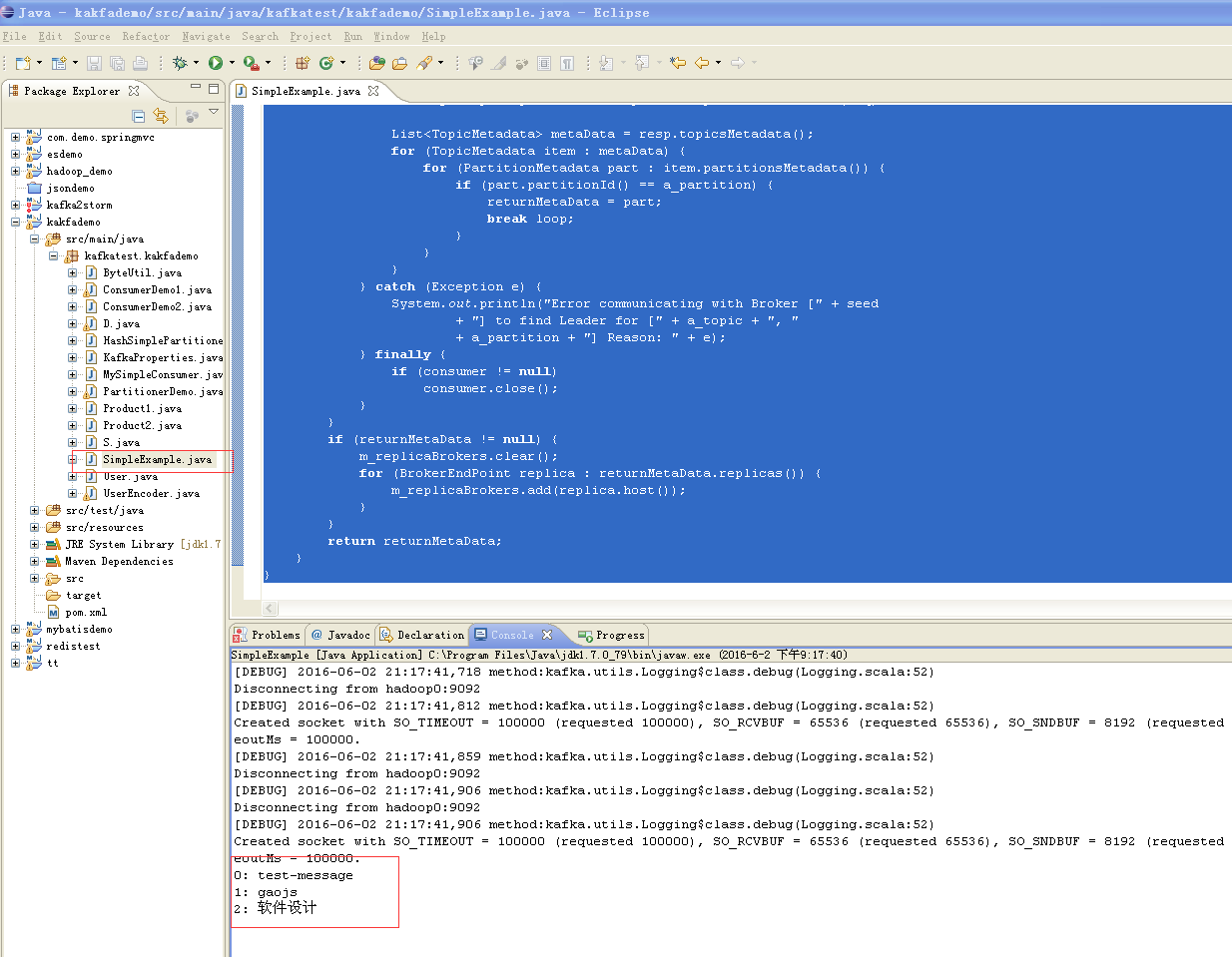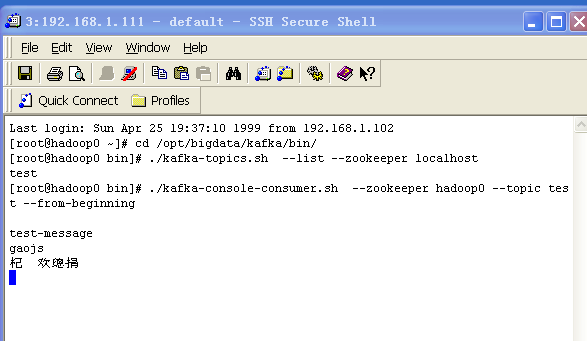这篇文章主要介绍“kafka的low-level consumer怎么使用”,在日常操作中,相信很多人在kafka的low-level consumer怎么使用问题上存在疑惑,小编查阅了各式资料,整理出简单好用的操作方法,希望对大家解答”kafka的low-level consumer怎么使用”的疑惑有所帮助!接下来,请跟着小编一起来学习吧!
一、什么时候用这个接口?
1)Read a message multiple times
2)Consume only a subset of the partitions in a topic in a process
3)Manage transactions to make sure a message is processed once and only once
二、使用SimpleConsumer的步骤:
1)Find an active Broker and find out which Broker is the leader for your topic and partition
2)Determine who the replica Brokers are for your topic and partition
3)Build the request defining what data you are interested in
4)Fetch the data ,Identify and recover from leader changes
首先,你必须知道读哪个topic的哪个partition
然后,找到负责该partition的broker leader,从而找到存有该partition副本的那个broker
再者,自己去写request并fetch数据
最终,还要注意需要识别和处理broker leader的改变
三、代码如下:
package kafkatest.kakfademo;
import java.nio.ByteBuffer;
import java.util.ArrayList;
import java.util.Collections;
import java.util.HashMap;
import java.util.List;
import java.util.Map;
import kafka.api.FetchRequest;
import kafka.api.FetchRequestBuilder;
import kafka.api.PartitionOffsetRequestInfo;
import kafka.cluster.BrokerEndPoint;
import kafka.common.ErrorMapping;
import kafka.common.TopicAndPartition;
import kafka.javaapi.FetchResponse;
import kafka.javaapi.OffsetResponse;
import kafka.javaapi.PartitionMetadata;
import kafka.javaapi.TopicMetadata;
import kafka.javaapi.TopicMetadataRequest;
import kafka.javaapi.consumer.SimpleConsumer;
import kafka.message.MessageAndOffset;
public class SimpleExample {
public static void main(String args[]) {
SimpleExample example = new SimpleExample();
long maxReads = 10;
String topicName = "test";
int partition = 0;
List<String> seeds = new ArrayList<String>();
seeds.add("hadoop0");
int port = 9092;
try {
example.run(maxReads, topicName, partition, seeds, port);
} catch (Exception e) {
System.out.println("Oops:" + e);
e.printStackTrace();
}
}
private List<String> m_replicaBrokers = new ArrayList<String>();
public SimpleExample() {
m_replicaBrokers = new ArrayList<String>();
}
public void run(long a_maxReads, String a_topic, int a_partition,
List<String> a_seedBrokers, int a_port) throws Exception {
// find the meta data about the topic and partition we are interested in
//
PartitionMetadata metadata = findLeader(a_seedBrokers, a_port, a_topic,
a_partition);
if (metadata == null) {
System.out
.println("Can't find metadata for Topic and Partition. Exiting");
return;
}
if (metadata.leader() == null) {
System.out
.println("Can't find Leader for Topic and Partition. Exiting");
return;
}
String leadBroker = metadata.leader().host();
String clientName = "Client_" + a_topic + "_" + a_partition;
SimpleConsumer consumer = new SimpleConsumer(leadBroker, a_port,
100000, 64 * 1024, clientName);
long readOffset = getLastOffset(consumer, a_topic, a_partition,
kafka.api.OffsetRequest.EarliestTime(), clientName);
int numErrors = 0;
while (a_maxReads > 0) {
if (consumer == null) {
consumer = new SimpleConsumer(leadBroker, a_port, 100000,
64 * 1024, clientName);
}
// Note: this fetchSize of 100000 might need to be increased if
// large batches are written to Kafka
FetchRequest req = new FetchRequestBuilder().clientId(clientName)
.addFetch(a_topic, a_partition, readOffset, 100000).build();
FetchResponse fetchResponse = consumer.fetch(req);
if (fetchResponse.hasError()) {
numErrors++;
// Something went wrong!
short code = fetchResponse.errorCode(a_topic, a_partition);
System.out.println("Error fetching data from the Broker:"
+ leadBroker + " Reason: " + code);
if (numErrors > 5)
break;
if (code == ErrorMapping.OffsetOutOfRangeCode()) {
// We asked for an invalid offset. For simple case ask for
// the last element to reset
readOffset = getLastOffset(consumer, a_topic, a_partition,
kafka.api.OffsetRequest.LatestTime(), clientName);
continue;
}
consumer.close();
consumer = null;
leadBroker = findNewLeader(leadBroker, a_topic, a_partition,
a_port);
continue;
}
numErrors = 0;
long numRead = 0;
for (MessageAndOffset messageAndOffset : fetchResponse.messageSet(
a_topic, a_partition)) {
long currentOffset = messageAndOffset.offset();
if (currentOffset < readOffset) {
System.out.println("Found an old offset: " + currentOffset
+ " Expecting: " + readOffset);
continue;
}
readOffset = messageAndOffset.nextOffset();
ByteBuffer payload = messageAndOffset.message().payload();
byte[] bytes = new byte[payload.limit()];
payload.get(bytes);
System.out.println(String.valueOf(messageAndOffset.offset())
+ ": " + new String(bytes, "UTF-8"));
numRead++;
a_maxReads--;
}
if (numRead == 0) {
try {
Thread.sleep(1000);
} catch (InterruptedException ie) {
}
}
}
if (consumer != null)
consumer.close();
}
public static long getLastOffset(SimpleConsumer consumer, String topic,
int partition, long whichTime, String clientName) {
TopicAndPartition topicAndPartition = new TopicAndPartition(topic,
partition);
Map<TopicAndPartition, PartitionOffsetRequestInfo> requestInfo = new HashMap<TopicAndPartition, PartitionOffsetRequestInfo>();
requestInfo.put(topicAndPartition, new PartitionOffsetRequestInfo(
whichTime, 1));
kafka.javaapi.OffsetRequest request = new kafka.javaapi.OffsetRequest(
requestInfo, kafka.api.OffsetRequest.CurrentVersion(),
clientName);
OffsetResponse response = consumer.getOffsetsBefore(request);
if (response.hasError()) {
System.out
.println("Error fetching data Offset Data the Broker. Reason: "
+ response.errorCode(topic, partition));
return 0;
}
long[] offsets = response.offsets(topic, partition);
return offsets[0];
}
private String findNewLeader(String a_oldLeader, String a_topic,
int a_partition, int a_port) throws Exception {
for (int i = 0; i < 3; i++) {
boolean goToSleep = false;
PartitionMetadata metadata = findLeader(m_replicaBrokers, a_port,
a_topic, a_partition);
if (metadata == null) {
goToSleep = true;
} else if (metadata.leader() == null) {
goToSleep = true;
} else if (a_oldLeader.equalsIgnoreCase(metadata.leader().host())
&& i == 0) {
// first time through if the leader hasn't changed give
// ZooKeeper a second to recover
// second time, assume the broker did recover before failover,
// or it was a non-Broker issue
//
goToSleep = true;
} else {
return metadata.leader().host();
}
if (goToSleep) {
try {
Thread.sleep(1000);
} catch (InterruptedException ie) {
}
}
}
System.out
.println("Unable to find new leader after Broker failure. Exiting");
throw new Exception(
"Unable to find new leader after Broker failure. Exiting");
}
private PartitionMetadata findLeader(List<String> a_seedBrokers,
int a_port, String a_topic, int a_partition) {
PartitionMetadata returnMetaData = null;
loop: for (String seed : a_seedBrokers) {
SimpleConsumer consumer = null;
try {
consumer = new SimpleConsumer(seed, a_port, 100000, 64 * 1024,
"leaderLookup");
List<String> topics = Collections.singletonList(a_topic);
TopicMetadataRequest req = new TopicMetadataRequest(topics);
kafka.javaapi.TopicMetadataResponse resp = consumer.send(req);
List<TopicMetadata> metaData = resp.topicsMetadata();
for (TopicMetadata item : metaData) {
for (PartitionMetadata part : item.partitionsMetadata()) {
if (part.partitionId() == a_partition) {
returnMetaData = part;
break loop;
}
}
}
} catch (Exception e) {
System.out.println("Error communicating with Broker [" + seed
+ "] to find Leader for [" + a_topic + ", "
+ a_partition + "] Reason: " + e);
} finally {
if (consumer != null)
consumer.close();
}
}
if (returnMetaData != null) {
m_replicaBrokers.clear();
for (BrokerEndPoint replica : returnMetaData.replicas()) {
m_replicaBrokers.add(replica.host());
}
}
return returnMetaData;
}
}
四、消费结果如下:


到此,关于“kafka的low-level consumer怎么使用”的学习就结束了,希望能够解决大家的疑惑。理论与实践的搭配能更好的帮助大家学习,快去试试吧!若想继续学习更多相关知识,请继续关注亿速云网站,小编会继续努力为大家带来更多实用的文章!
免责声明:本站发布的内容(图片、视频和文字)以原创、转载和分享为主,文章观点不代表本网站立场,如果涉及侵权请联系站长邮箱:is@yisu.com进行举报,并提供相关证据,一经查实,将立刻删除涉嫌侵权内容。